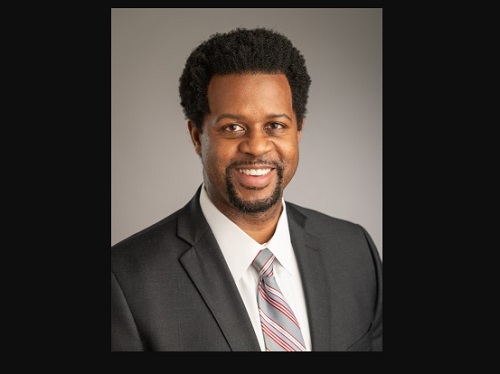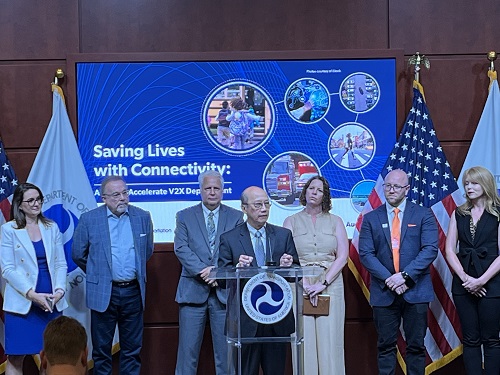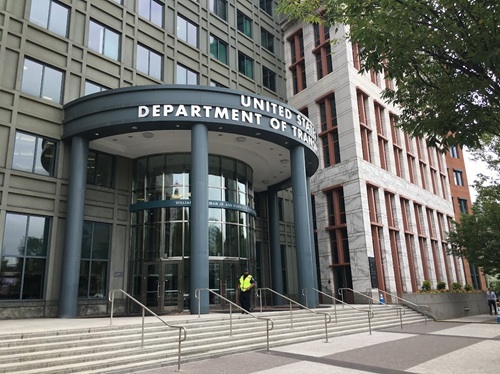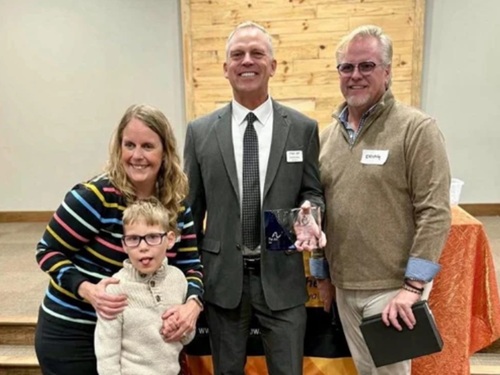The U.S. Department of Transportation unveiled the finalized version of its vehicle-to-everything or V2X technology national deployment plan at a press event held at the agency’s Washington, D.C., headquarters on August 16.
[Above image by USDOT]
The 19-page plan – officially entitled “Saving Lives with Connectivity: A Plan to Accelerate V2X Deployment” and initially released in draft form for public comment in October 2023 – is focused on improving road safety, mobility, and efficiency through the broader use of V2X technology, which enables vehicles and wireless devices to communicate with each other and with roadside infrastructure.
“The plan was drafted and advanced with collaboration across public and private partnerships,” noted Dr. Robert Hampshire, USDOT’s principal deputy assistant secretary for research and technology and chief scientist, in a statement.

“It provides stakeholders with vital information to enable a safe, efficient, and sustainable transportation system through the national, widespread deployment of interoperable V2X technologies,” he added.
USDOT noted that its V2X plan also recognizes that nationwide deployment of V2X technology will not happen overnight, and that it will take a “coordinated, long-term engagement from both public agencies and private industry to deliver a nationwide V2X network.”
To that end, the USDOT said its plan identifies short-, medium-, and long-term goals to coordinate collective deployment efforts – articulating distinct responsibilities among federal agencies, infrastructure owner-operators, and private industry to achieve an interoperable V2X network across the nation.
According to the Intelligent Transportation Society of America, the plan also serves as a “starting point” for defining USDOT’s vision for how V2X applications outside of the 5.9 GHz wireless communication spectrum will fit into its national V2X strategy – an important step in achieving interoperability among the various applications and approaches being deployed today that make up the larger V2X ecosystem.
“[This] plan represents a significant milestone in the transportation sector’s journey to deliver a scaled, interoperable V2X network that will save lives and improve outcomes for road users across the country,” noted Laura Chace, ITS America’s president and CEO, in a separate statement.

King Gee, director of safety and mobility for the American Association of State Highway and Transportation Officials, noted in remarks at the event that state departments of transportation “stand ready” to implement V2X applications through the refinement of standards, coordination of deployments, and the sharing of “lessons learned” via that process.
“As AASHTO represents the state DOTs which play a key role in V2X deployment, we are excited that USDOT is launching this coherent national plan for deploying V2X applications to save lives,” he said. “This plan provides certainty and direction with which state DOTs can move beyond pilots and demonstrations to deployment at scale.”
As part of the effort to deploy V2X technologies more broadly across the nation, the Federal Highway Administration issued a $60 million funding package in June to support V2X initiatives in Arizona, Texas, and Utah; a project that aims to serve as a national model to accelerate and spur new deployments of V2X technologies.
That fiscal support “will help accelerate the technology so that we can deploy it on a national scale and provide new tools to combat fatalities on our nation’s highways,” explained Shailen Bhatt, FHWA’s administrator, at a press event for that funding announcement hosted by the Utah Department of Transportation.
 Top Stories
Top Stories
USDOT Issues $1B in Local Road Safety Funding
January 2, 2026 Top Stories
Top Stories

